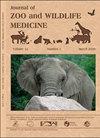Ivan I Castillo, Sudona Nelson, Karisa Tang, Shiyuan Deng, William Van Bonn, Matthew O'Connor, Kathryn C Gamble
求助PDF
{"title":"物种生存计划内非洲企鹅(spheniscus demersus)中的Spheniscid α疱疹病毒1©美国管理种群:发病率和种群影响。","authors":"Ivan I Castillo, Sudona Nelson, Karisa Tang, Shiyuan Deng, William Van Bonn, Matthew O'Connor, Kathryn C Gamble","doi":"10.1638/2023-0116","DOIUrl":null,"url":null,"abstract":"<p><p>Spheniscid alphaherpesvirus-1 (SpAHV-1) is associated with respiratory disease in juvenile African penguins (<i>Spheniscus demersus</i>). In 2020, this virus was detected in adult birds with clinical signs of respiratory disease in a previously asymptomatic colony of 21 birds following a recommended introduction of three new birds, including two with a history of herpesvirus as juveniles. Mild to moderate respiratory signs were noted in 33% (8/24) of the colony. SpAHV-1 DNA was detected in respiratory secreta by herpesvirus consensus PCR in three birds, although as the definitive source of the presentation, it could not be confirmed. Surveillance for SpAHV-1 was performed in all colony birds seven and 19 mo following resolution of respiratory disease signs. SpAHV-1 was detected via consensus herpesvirus PCR and sequencing in two apparently healthy individuals, including one which had clinical signs of respiratory disease and tested positive for SpAHV-1 during the original outbreak. Due to limited knowledge about this pathogen, a retrospective assessment regarding SpAHV-1 and respiratory disease was performed by analyzing survey data collected from 41 institutions holding African penguins in the Species Survival Plan<sup>©</sup> (SSP) North American population from 2011-2021. From the 41 institutions that participated, 782 birds were evaluated and assessed, representing 70% of the total available population (n = 1,116). The majority (80%; 33/41) of participating institutions' veterinarians reported no knowledge of SpAHV-1 prior to this survey. Respiratory disease (e.g., sneezing, coughing, nasal discharge, oropharyngeal plaques, pulmonary auscultation changes) was reported in 21.2% of the surveyed cohort. Most clinical signs were resolved within 3-30 dy, with an average duration of illness of 13 dy. The odds of respiratory disease were significantly higher in males (<i>p</i> < 0.0001) and in non-transferred penguins as compared to those penguins transferred between institutions (<i>p</i> = 0.005). Only 5.6% of penguins (44/782) were tested for herpesviruses by PCR during the study period and of these birds, 18% (8/44) were positive for SpAHV-1. SpAHV-1 represents an important differential for respiratory disease in African penguins, but additional epidemiologic research is needed to determine the full impact of this pathogen.</p>","PeriodicalId":17667,"journal":{"name":"Journal of Zoo and Wildlife Medicine","volume":"56 1","pages":"89-95"},"PeriodicalIF":0.7000,"publicationDate":"2025-03-01","publicationTypes":"Journal Article","fieldsOfStudy":null,"isOpenAccess":false,"openAccessPdf":"","citationCount":"0","resultStr":"{\"title\":\"SPHENISCID ALPHAHERPESVIRUS 1 IN AFRICAN PENGUINS (<i>SPHENISCUS DEMERSUS</i>) WITHIN THE SPECIES SURVIVAL PLAN<sup>©</sup> MANAGED POPULATION IN THE US: INCIDENCE AND POPULATION IMPACT.\",\"authors\":\"Ivan I Castillo, Sudona Nelson, Karisa Tang, Shiyuan Deng, William Van Bonn, Matthew O'Connor, Kathryn C Gamble\",\"doi\":\"10.1638/2023-0116\",\"DOIUrl\":null,\"url\":null,\"abstract\":\"<p><p>Spheniscid alphaherpesvirus-1 (SpAHV-1) is associated with respiratory disease in juvenile African penguins (<i>Spheniscus demersus</i>). In 2020, this virus was detected in adult birds with clinical signs of respiratory disease in a previously asymptomatic colony of 21 birds following a recommended introduction of three new birds, including two with a history of herpesvirus as juveniles. Mild to moderate respiratory signs were noted in 33% (8/24) of the colony. SpAHV-1 DNA was detected in respiratory secreta by herpesvirus consensus PCR in three birds, although as the definitive source of the presentation, it could not be confirmed. Surveillance for SpAHV-1 was performed in all colony birds seven and 19 mo following resolution of respiratory disease signs. SpAHV-1 was detected via consensus herpesvirus PCR and sequencing in two apparently healthy individuals, including one which had clinical signs of respiratory disease and tested positive for SpAHV-1 during the original outbreak. Due to limited knowledge about this pathogen, a retrospective assessment regarding SpAHV-1 and respiratory disease was performed by analyzing survey data collected from 41 institutions holding African penguins in the Species Survival Plan<sup>©</sup> (SSP) North American population from 2011-2021. From the 41 institutions that participated, 782 birds were evaluated and assessed, representing 70% of the total available population (n = 1,116). The majority (80%; 33/41) of participating institutions' veterinarians reported no knowledge of SpAHV-1 prior to this survey. Respiratory disease (e.g., sneezing, coughing, nasal discharge, oropharyngeal plaques, pulmonary auscultation changes) was reported in 21.2% of the surveyed cohort. Most clinical signs were resolved within 3-30 dy, with an average duration of illness of 13 dy. The odds of respiratory disease were significantly higher in males (<i>p</i> < 0.0001) and in non-transferred penguins as compared to those penguins transferred between institutions (<i>p</i> = 0.005). Only 5.6% of penguins (44/782) were tested for herpesviruses by PCR during the study period and of these birds, 18% (8/44) were positive for SpAHV-1. SpAHV-1 represents an important differential for respiratory disease in African penguins, but additional epidemiologic research is needed to determine the full impact of this pathogen.</p>\",\"PeriodicalId\":17667,\"journal\":{\"name\":\"Journal of Zoo and Wildlife Medicine\",\"volume\":\"56 1\",\"pages\":\"89-95\"},\"PeriodicalIF\":0.7000,\"publicationDate\":\"2025-03-01\",\"publicationTypes\":\"Journal Article\",\"fieldsOfStudy\":null,\"isOpenAccess\":false,\"openAccessPdf\":\"\",\"citationCount\":\"0\",\"resultStr\":null,\"platform\":\"Semanticscholar\",\"paperid\":null,\"PeriodicalName\":\"Journal of Zoo and Wildlife Medicine\",\"FirstCategoryId\":\"97\",\"ListUrlMain\":\"https://doi.org/10.1638/2023-0116\",\"RegionNum\":4,\"RegionCategory\":\"农林科学\",\"ArticlePicture\":[],\"TitleCN\":null,\"AbstractTextCN\":null,\"PMCID\":null,\"EPubDate\":\"\",\"PubModel\":\"\",\"JCR\":\"Q3\",\"JCRName\":\"VETERINARY SCIENCES\",\"Score\":null,\"Total\":0}","platform":"Semanticscholar","paperid":null,"PeriodicalName":"Journal of Zoo and Wildlife Medicine","FirstCategoryId":"97","ListUrlMain":"https://doi.org/10.1638/2023-0116","RegionNum":4,"RegionCategory":"农林科学","ArticlePicture":[],"TitleCN":null,"AbstractTextCN":null,"PMCID":null,"EPubDate":"","PubModel":"","JCR":"Q3","JCRName":"VETERINARY SCIENCES","Score":null,"Total":0}
引用次数: 0
引用
批量引用

 求助内容:
求助内容: 应助结果提醒方式:
应助结果提醒方式:


